The global leader in enterprise social media management
For over a decade, Sprinklr Social has helped the world’s biggest brands reimagine social media as a growth driver with a unified platform, industry-leading AI and enterprise-grade scale.
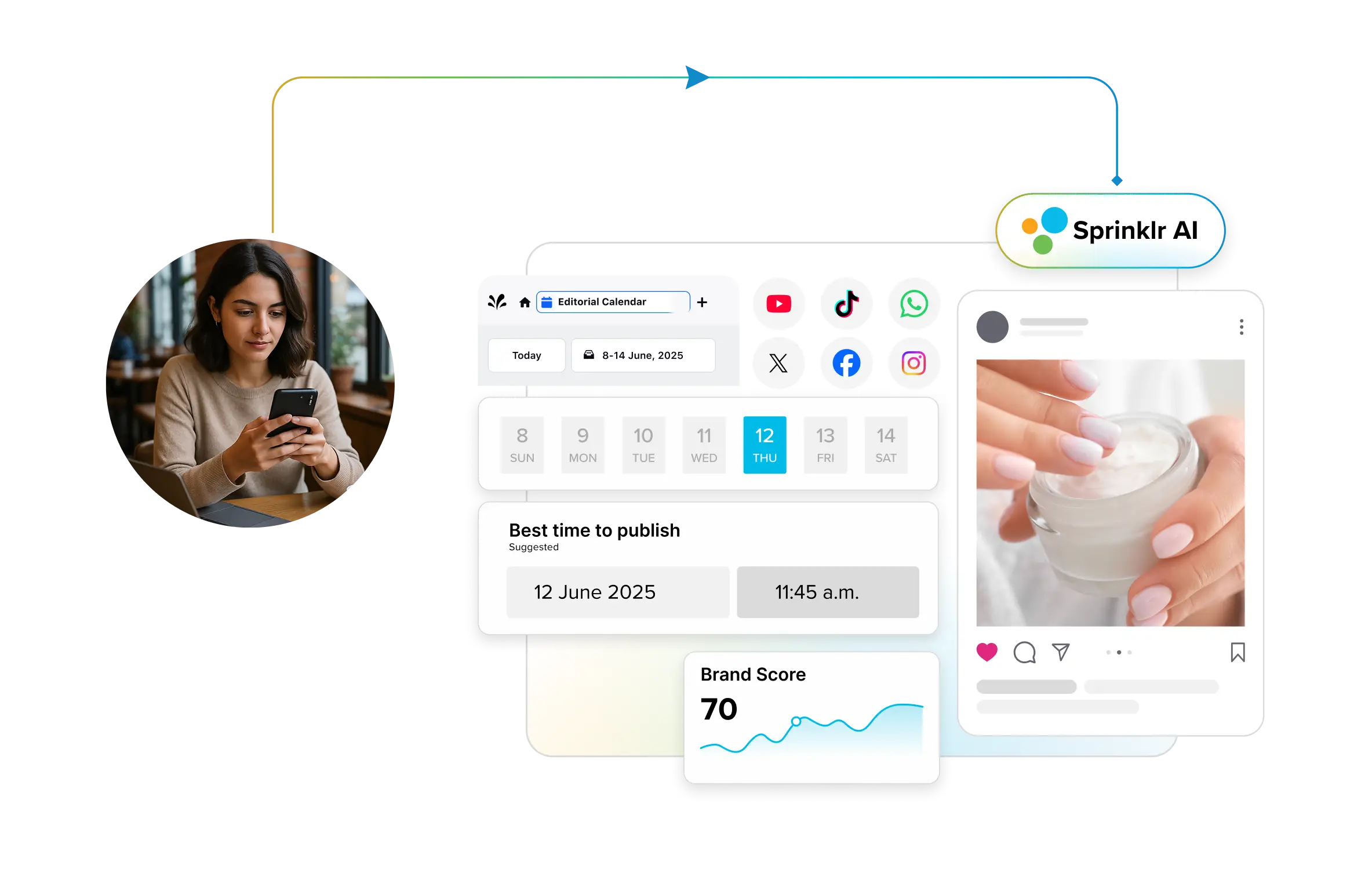
Social Media Crisis Management: 6 Proven Strategies for 2025
A single tweet. A deepfake video. A customer complaint amplified by millions.
In 2025, social media crises of this sort don’t unfold over days; they erupt in minutes. With the rise of AI-generated content and lightning-fast virality, even a small incident can spiral into a full-blown reputational and financial disaster.
Yet only 49% of U.S. companies have a formal crisis communication plan. That leaves most brands, especially those operating at scale, dangerously exposed.
Today, social media crisis management is no longer the domain of PR alone. It's a cross-functional, business-critical capability that involves legal, customer support, marketing, and technology teams. AI is reshaping both the risks and the solutions, making this a top concern for every C-suite.
In this blog, we’ll break down six proven strategies for managing social media crises in 2025. You’ll discover real-world examples, see how automation can help you respond faster, and learn what it takes to protect your global reputation, and bottom line.
- What is social media crisis management?
- Why is social media crisis management crucial in 2025?
- 6 proven strategies for social media crisis management and response
- Real-world examples of social media crisis management
- Best practices for social media crisis management in 2025
- Bonus: Enterprise crisis reports in the digital age
- Wrapping it up: Stay agile and proactive
What is social media crisis management?
Social media crisis management is the disciplined practice of preparing for, identifying, and quickly resolving brand-threatening issues on social platforms before they spiral.
A social media crisis can be anything that seriously damages your reputation, not just a few angry reviews or a single critical post. It might look like public backlash over an insensitive campaign, misinformation spreading unchecked, data breaches exposing customers’ private information, a product safety issue going viral, or a senior executive’s behavior going public.
With over 5 billion people on social, even one critical post can escalate into a full-blown global reputational crisis — often within minutes. Unlike traditional PR, where messages move through formal channels and scheduled releases, social media spreads unchecked across diverse audiences in real time. That speed, combined with the challenge of managing narratives across regions and languages, raises the stakes for brands, and makes a proactive crisis plan a core pillar of business resilience.
That means going beyond reactive fixes. A strong social media crisis management plan spells out clear escalation tiers, pre-approved messaging, AI-powered social listening to catch warning signs early, and cross-functional teams trained to respond with speed and empathy.
As Siena Siekman, VP of Analytics & Optimization at Athena Global Advisors, puts it:
“Even after a decade in this industry, I’m still amazed at how many people share their opinions online and the range of niche topics that gain traction. Sprinklr allows us to quickly identify these conversations, add context and escalate emerging issues to the right teams within our clients’ organizations, be it PR, security or customer service.”
Curious how they turned the crisis around, and what measurable impact it had? Read the full story here!
When executed well, crisis management on social media not only contains damage; it protects your brand, strengthens trust, and even sharpens your competitive edge.
Suggested Read: How to Manage a Social Media Crisis Efficiently
Why is social media crisis management crucial in 2025?
Because today’s crises erupt faster, and cost more than ever.
In 2025, a stray tweet or an AI-fueled deepfake can spark a global firestorm in minutes, forcing enterprises into the spotlight before they’ve had a chance to react. According to Gartner, a perceived decline in social media quality will drive 50% of consumers to abandon or significantly reduce their social interactions by 2025. That erosion is fueled by misinformation, toxic discourse, bots, and now, the looming impact of generative AI.
That matters because:
- Your customers’ trust is already fragile. If they’re stepping back from social, they’ll have zero tolerance for brands that mishandle a crisis; they’ll simply leave.
- Public scrutiny is immediate and global. Even a minor issue can escalate into investor concern, legal scrutiny, and long-term reputational damage across every region you operate in.
- Recovery is costly. Rebuilding brand equity after a viral backlash can take years and millions in spend. Every unmanaged crisis eats into loyalty, stock value, and future growth.
- Your competitors won’t wait. A crisis that slows down your team is an opportunity for others to win customers, talent, and market share.
And all of this plays out in real time.
Take Jaguar’s recent crisis as a cautionary tale. Following misinformation about its advertising, hashtags like #BoycottJaguar and #Faguar exploded across social channels. Fake profiles, accounting for up to 20% of those engaging, fanned the flames, generating thousands of posts and nearly 500,000 views. Negative articles spiked to 3,788 in a single week, and fake accounts even revived old articles that had lost traction, bringing them back into public view.

Jaguar’s generic, automated responses only amplified the anger, allowing a single tweet from an influencer to rack up 3.4 million views and drive even more engagement.
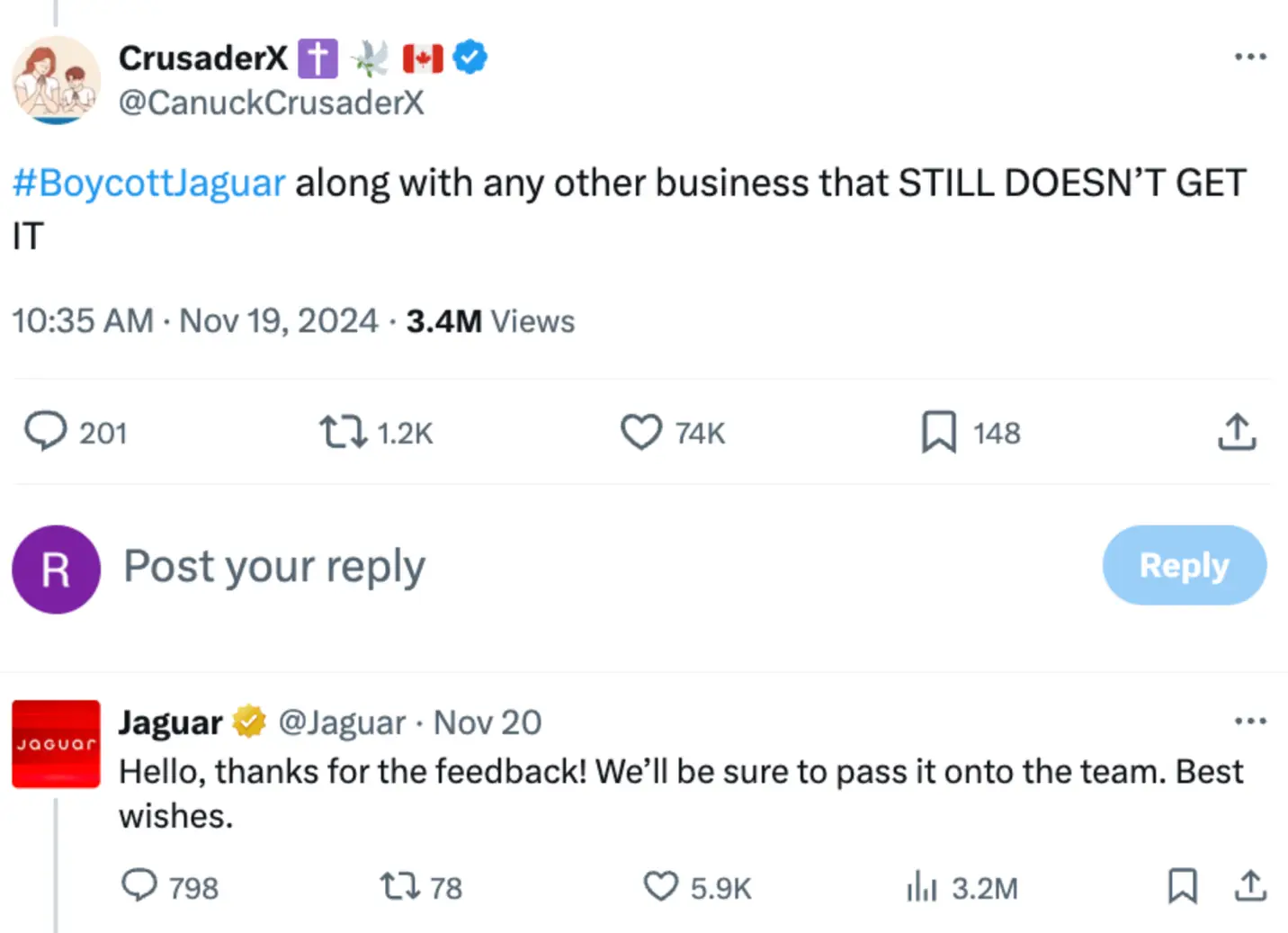
As the Jaguar case above makes clear, even a well-known global brand can lose control of its narrative in hours without the right systems and processes in place.
In an environment this volatile, crisis management is less about damage control and more about resilience, relevance, reputation, and long-term growth. Equipped with real-time data, AI-driven tools, and a proactive plan, brands don’t just survive a crisis — they show their customers and investors they can navigate the unpredictable with agility and integrity.
Learn More: How Generative AI Is Transforming Crisis Management
6 proven strategies for social media crisis management and response
When a crisis erupts on social media, every second matters. A slow or fragmented response can erode trust, damage your reputation, and impact the bottom line. These six proven strategies help you act quickly, align your teams, and protect your brand:
1. Set up a real-time command center
Your team needs a cross-functional digital war room; one centralized space where marketing, PR, legal, and customer support can align instantly. Modern platforms like Sprinklr make this easy — offering a single interface to monitor social channels, triage issues, and publish responses instantly.
- Define roles and workflows: Pre-assign responsibilities — who drafts responses, who escalates to legal, and who handles approvals.
- Unify communications: Use shared dashboards and live alerts so all team members see evolving conversations as they happen.
- Respond decisively: Enable one-click escalation paths, so critical issues are surfaced and handled immediately.
Why this matters:
Crisis intensity on social is real: McKinsey reports that 50% of consumers post complaints publicly after bad experiences, and 81% say they’ll avoid brands that don’t respond publicly. A command center helps you respond in minutes, not hours.
Expert-backed approach: FGS Global recommends real-time “Operations Rooms” to track evolving crises and coordinate a swift, unified response.
Example: When American Airlines faced a critical incident in January 2025, it activated its social crisis protocol within an hour — posting updates, deploying support resources, and sharing a video message from its CEO. That clarity and speed helped protect its reputation when every moment counted.
The result? Greater control of the narrative, reduced misinformation, and a quicker path to rebuilding public trust; all made possible by one unified response team and a single source of truth.
More to read: Social Media Crisis Communication: Strategy, Examples and Resolution
2. Define crisis tiers and response playbooks
Not every trending hashtag is a full-blown crisis, but every issue needs the right level of response, especially at scale. A tiered system paired with pre-approved playbooks helps your team act fast and stay aligned when social media scrutiny hits.
How to set it up:
Define Low, Medium, and High tiers with clear response protocols:
Tier | Social Scenario | Key Actions | Stakeholders | Approval Workflow |
Low | Misinformation, isolated complaint posts | Correct false info with fact-based messaging | Social, PR | Comms lead review |
Medium | Widespread service complaints, local outages | Acknowledge publicly, update regularly, and provide a resolution timeline | IT, Support, Social, Comms | Cross-functional review |
High | Viral boycott hashtag, legal/ethical issues | Executive video or statement, public apology, legal involvement | Executive leadership, Legal, PR | Legal + C-suite approval |
Social media crises don’t follow linear paths. A local complaint at 9 AM, like a delayed delivery shared by one customer, can escalate into a viral post by noon if ignored. With clear tiers and pre-approved playbooks, your team can move fast before a minor issue snowballs into a reputation-damaging incident.
Situational Crisis Communication Theory (SCCT) backs this: your response strategy must match your crisis’s nature and severity.
Pro tip: Set specific escalation triggers, like a 3x spike in mentions or a 20% drop in sentiment within an hour — then pair them with AI-driven tools like Sprinklr Social that do the heavy lifting for you.
Sprinklr’s automated Engagement Intuition model scans all incoming messages across owned and earned channels in real time and classifies them as engageable or non-engageable based on message content, user profile, and past interactions. That way, your team stays focused on the most relevant conversations, not manual message triage, and can jump in before issues gain public traction.
Want to learn more?
3. Leverage AI-powered social listening
Platform monitoring isn’t enough. Brands need predictive tools that surface signals before they escalate into full-scale crises. AI-powered listening combines scale, context, and speed to give your team the edge.
The faster you spot an issue, the more control you have over how it unfolds. AI-powered social listening gives brands a head start before news breaks or negative sentiment hits critical mass.
What it looks like in action:
- Real-time alerts: Tools like Sprinklr Smart Alerts flag sudden drops in sentiment or spikes in social media engagement tied to key terms, whether it’s #BrandFail or a viral influencer mention.
- Root cause detection: AI analyzes text clusters to surface the underlying issue — product concerns, misinformation, or campaign backlash, allowing targeted and informed responses.
💡 Pro tip: Tap into Sprinklr’s Topic Analysis widget (plotted in any custom Reporting dashboard) to get an instant read on what people are really talking about — good, bad, or trending.
It visually breaks down the most-used words and themes across your social channels, so you can spot rising complaints, viral myths, or new pain points before they explode. Plus, you can click into each topic for a deeper dive and see exactly what’s driving the conversation.
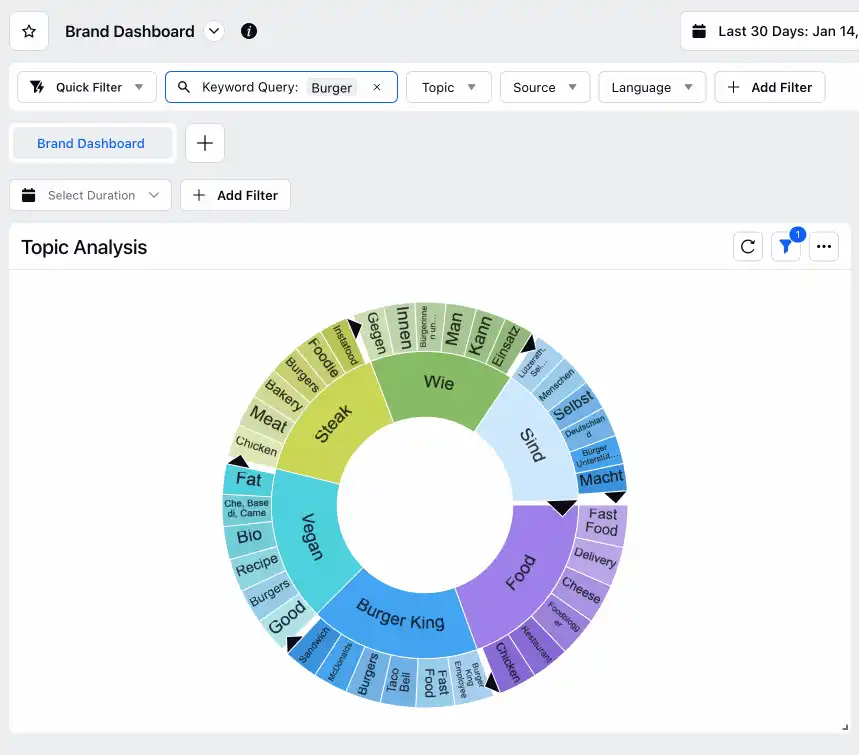
It’s like having a 24/7 early-warning radar that helps you tackle the right issues, fast, and keep your brand one step ahead.
- Regional prioritization: Filter alerts by geography, platform, or volume so your team can prioritize what matters most globally.
- Automated workflows: Trigger internal comms, task assignments, or deploy pre-approved responses directly from the alert.
Why this matters:
- Speed matters: Detecting a brewing crisis even 30 minutes faster can mean the difference between stopping a rumor and facing viral brand damage.
- Accuracy matters: Fewer false alarms mean your team can trust alerts and act decisively, without wasting time.
- Coverage matters: Today’s conversations aren’t just text-based. Social listening must include voice, video, and visuals to fully track sentiment.
What you can implement:
→ Set alert parameters for your brand, product, campaign names, sentiment levels, and key phrases.
→ Connect listening to social media workflows so that when alerts fire, your command center is automatically engaged.
→ Refine models continuously as language evolves — sarcasm, slang, and new platforms all require constant updates to AI filters.
Talking about AI-powered social listening, Sprinklr’s Social Listening platform lets you tap into billions of real-time conversations across 30+ social and digital channels — with firehose access ensuring you never miss a mention. It doesn’t just listen; its AI automatically surfaces trends, themes, anomalies, and even logos in images and videos, so you catch crises before they go viral.
Plus, you can share actionable insights instantly across teams with customizable reports and automated alerts. In short: it’s your always-on early warning system for protecting your brand at scale.
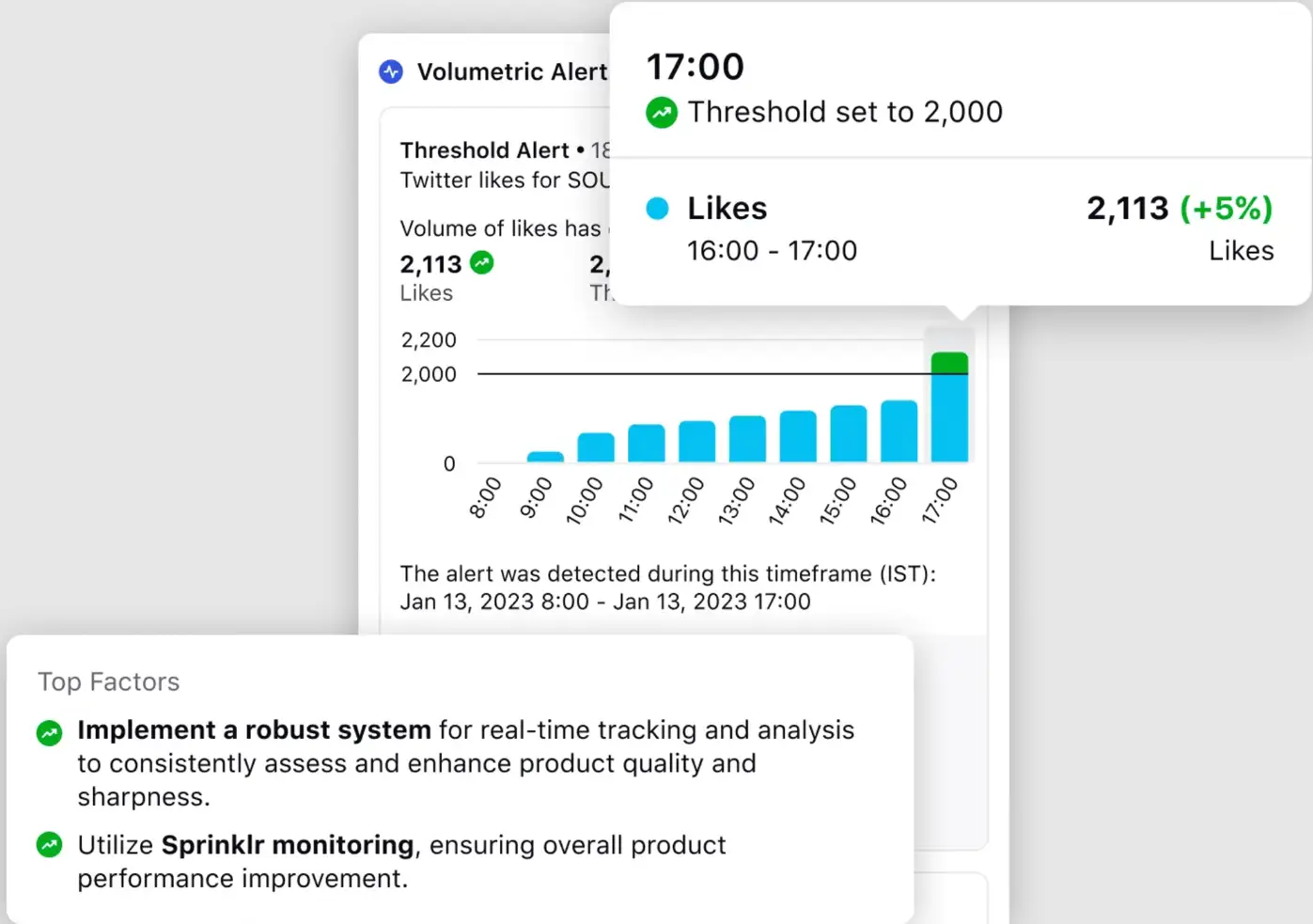
Intrigued? Grab a demo to see it live! 👇
4. Maintain a consistent brand voice
In a crisis, your voice is your signature. When posts go viral on social platforms, your tone needs to remain distinctly you, not generic or panicked.
Here’s how to do it right:
1. Codify your tone:
→ Define your brand voice, whether it's empathetic, professional, or candid
→ Translate that into adaptable message templates and pre-approved “holding” statements for when facts are still emerging
2. Build flexible templates: Create response frameworks for common scenarios (outages, product issues, executive responses), that can be localized by region or channel.
3. Use holding statements effectively: If you don’t have all the facts, post an early, empathetic acknowledgment. A simple message like, “We’re looking into this and will update you shortly,” shows responsiveness and reduces speculation.
4. Align all teams:
→ Ensure social, PR, CX, legal, and leadership all follow the same voice and message templates.
→ Consistency reduces the risk of off-brand or tone-deaf responses.
A consistent voice doesn’t just sound better; it performs better. Research shows 98% of business leaders who activated their crisis communication plans said they were effective and 77% said very effective.
When templates and tone guidelines are already in place, teams don’t waste time wordsmithing under pressure. They communicate with clarity, speed, and confidence.
In a crisis, don’t reinvent your voice; reinforce it. It’s what customers count on when everything else feels uncertain. In fact, research shows 72% of consumers will continue to do business with a brand that has experienced a crisis but addresses it swiftly and sincerely.
Want to keep every reply on-brand and drama-free?
It’s made possible with Sprinklr’s Smart Response Compliance!
Powered by AI, it scans every message, across all your social channels, for biased language, profanity, off-tone phrasing, or irrelevant content before you hit send. Whether you’re calming angry customers or acknowledging an issue, it ensures every response stays empathetic, on-message, and up to community standards.
The result? Faster replies, fewer PR surprises, and total confidence that your team’s voice is consistent, caring, and compliant at every touchpoint.
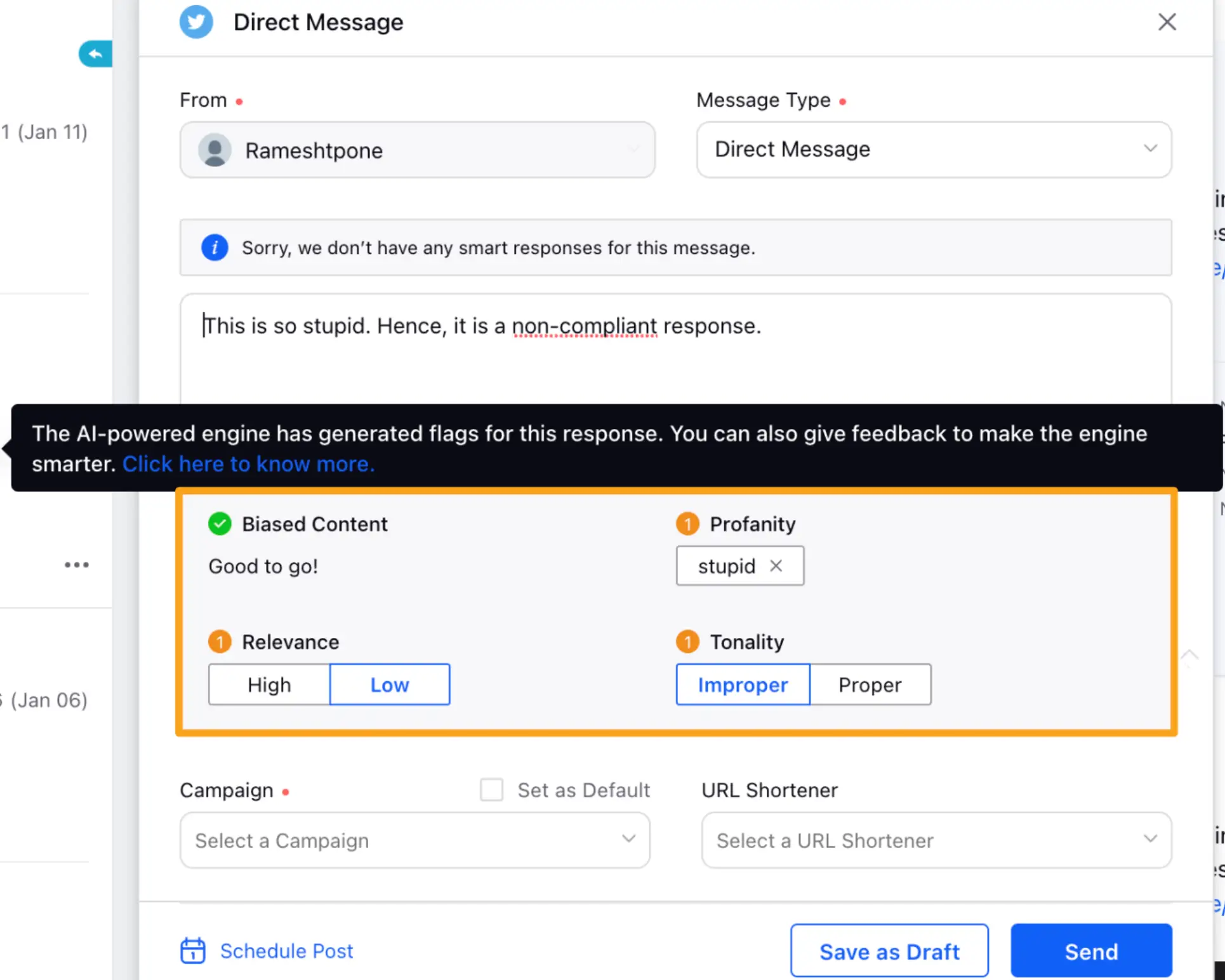
5. Train teams in AI-assisted crisis responses
You can’t improvise under fire. A crisis-ready team needs more than occasional media training — they need real-time practice powered by AI, realistic simulations, and data-driven insight. This prepares them to respond with clarity and speed when social media crises strike.
What this looks like:
- Real-time AI alerts and insights: Modern platforms like Sprinklr’s Social Listening sends instant alerts when sentiment drops or a viral hashtag spikes. AI filters out noise, so your team sees only the most impactful conversations, allowing you to act before issues escalate.
- Smart routing and response: Once an alert is triggered, AI can automatically route issues by severity to the appropriate teams (PR, legal, customer support), so the right people jump in immediately. Many tools also offer tone and message suggestions tailored to each situation, cutting drafting time and ensuring consistency. Infact, AI-generated response suggestions can cut average response times by 40%.
- Simulate crises for rapid learning: Crisis simulations using real-world social data, now standard with tools like Prevency and Social Simulator help teams practice under pressure. Participants respond to simulated viral posts and escalating threads, testing coordination, speed, and empathy before they ever face a real incident.
- Align teams and decision-makers: AI-assisted workflows keep everyone on the same page. Shared dashboards, role-specific notifications, and pre-approved templates mean you can scale decisions faster without endless back-and-forth.
AI-assisted crisis management isn’t about removing the human touch. It’s about making your human response faster, smarter, and less risky.
- Reduced response time = less viral spread
- Fewer legal/PR missteps = stronger brand protection
- Consistent tone and messaging = better customer trust
- Faster internal coordination = lower operational stress
In a high-stakes situation, you fall to the level of your training and tools. Make sure both are AI-ready.
Interesting Read: The Importance of Empathy in Crisis Response
6. Prioritize transparency and empathy
Silence or spin? Neither works in 2025. Audiences expect clear, human responses, and fast. But to manage this at scale, brands need both automation and authenticity.
- Acknowledge early: Even when details are limited, post a timely acknowledgement: “We know there’s been concern around this, and we’re actively investigating.” This early transparency builds credibility and prevents rumor gaps from growing.
- Speak human: Drop the legalese. Use empathetic, plain language that reflects your brand values. For example: “We understand your concern and are sorry for the worry this has caused.”
- Show the fix: Be clear about what you're doing, when they can expect the next update, and how you’ll communicate. Even simple timelines — “We will share an update by 3PM ET today”, help calm audiences.
- Build trust in the moment: Customers remember authenticity. Being straightforward in real time strengthens trust, even if the crisis isn’t over.
- Prepare responses in advance: Predictive AI tools can help you identify trending concerns early and suggest empathetic messaging before a crisis peaks.
- Use AI thoughtfully: AI tools can assist by drafting empathetic messages based on your tone guidelines. These drafts still require human review, ensuring sincerity without slowing down the response.
🤖 Pro Tip: Sprinklr AI+ helps you respond with heart and precision. It can suggest empathetic, on-brand replies, summarize complex cases, and pull accurate answers from your knowledge base — all while optimizing for tone and relevance.
Worried about AI going off-script? Sprinklr AI+ includes built-in guardrails to minimize risks like hallucinations, so your messages stay trustworthy and human. Only the content you actively enter is shared with third-party AI, keeping your data secure and your voice authentic.
Ignoring or downplaying a threat on social media only makes it worse. In 2025, preparedness means combining speed, empathy, and transparency, backed by AI-enabled tools and real human oversight.
Real-world examples of social media crisis management
Crisis doesn’t play favorites. But how you respond can define your brand for years. Here are some real-world social media crisis management examples to learn from:
1. e.l.f. Cosmetics
Crisis: Viral TikTok videos falsely claimed harmful ingredients in e.l.f. products, leading to boycott threats and a growing credibility gap.
Response:
- Launched an Ingredient Safety and Transparency Policy, spotlighting its use of RSPO-certified palm ingredients and clean beauty commitments
- Instead of deflecting, the brand engaged directly on TikTok, where the narrative had emerged, using factual responses, short-form videos, and creator partnerships to clarify misconceptions
Outcome & learnings:
- Reversed negative sentiment across platforms
- Strengthened trust with Gen Z
What worked: Platform-native transparency and influencer-led truth-sharing. What didn’t: Initial delay allowed misinformation to gain traction, highlighting the need for early detection.
2. Majid Al Futtaim
Crisis: The sudden surge in online interactions during COVID-19 created an unpredictable volume of customer queries and complaints. Rapidly shifting customer behavior meant Majid Al Futtaim had to scale its response across multiple markets and channels overnight.
Response:
- Deployed Sprinklr’s social listening to capture earned and owned mentions across all digital touchpoints
- Introduced COVID-specific keyword filters to surface actionable cases faster
- Deployed automated rule engines to triage incoming posts
Outcome & learnings:
- Maintained mostly positive sentiment during the pandemic
- Accelerated cross-functional decision-making and customer responsiveness
What worked:
- Real-time monitoring and escalation across all markets kept customer trust high
- Rapid routing to the right team ensured specialized responses that met customers’ evolving expectations
What didn’t: Initially, scattered data sources created blind spots, underlining the need for early centralization and automation.
3. Chick-fil-A
Crisis: 2016 backlash after replacing Original BBQ sauce — 73% negative sentiment and a viral boycott hashtag (#BringBackTheBBQ).
Response:
- Used Sprinklr dashboards to monitor social sentiment
- Built a custom engagement dashboard to respond personally to customers across platforms
- Relaunched the Original BBQ sauce with a high-touch campaign, including fan outreach kits and personalized messages
Outcome & learnings:
- 92% positive sentiment after relaunch
- 188x spike in mentions on launch day
- 5,000+ interactions within 72 hours and over 1,000 organic hashtag mentions
What worked: Personal outreach and using social listening to guide action. What didn’t: Initial silence stalled engagement, demonstrating the cost of ignoring real-time sentiment.
Want to tackle crises like these in record time?
Brands that responded with speed, focus, and data-driven decisions are often powered by the right tools.
That’s exactly where Sprinklr’s Crisis Management solution shines. It lets teams spot trouble before it explodes, respond up to 3× faster, and monitor every corner of the internet — across 30+ social and digital channels, 400K+ media sources, and 1B+ websites and review sites, so you never miss a signal.
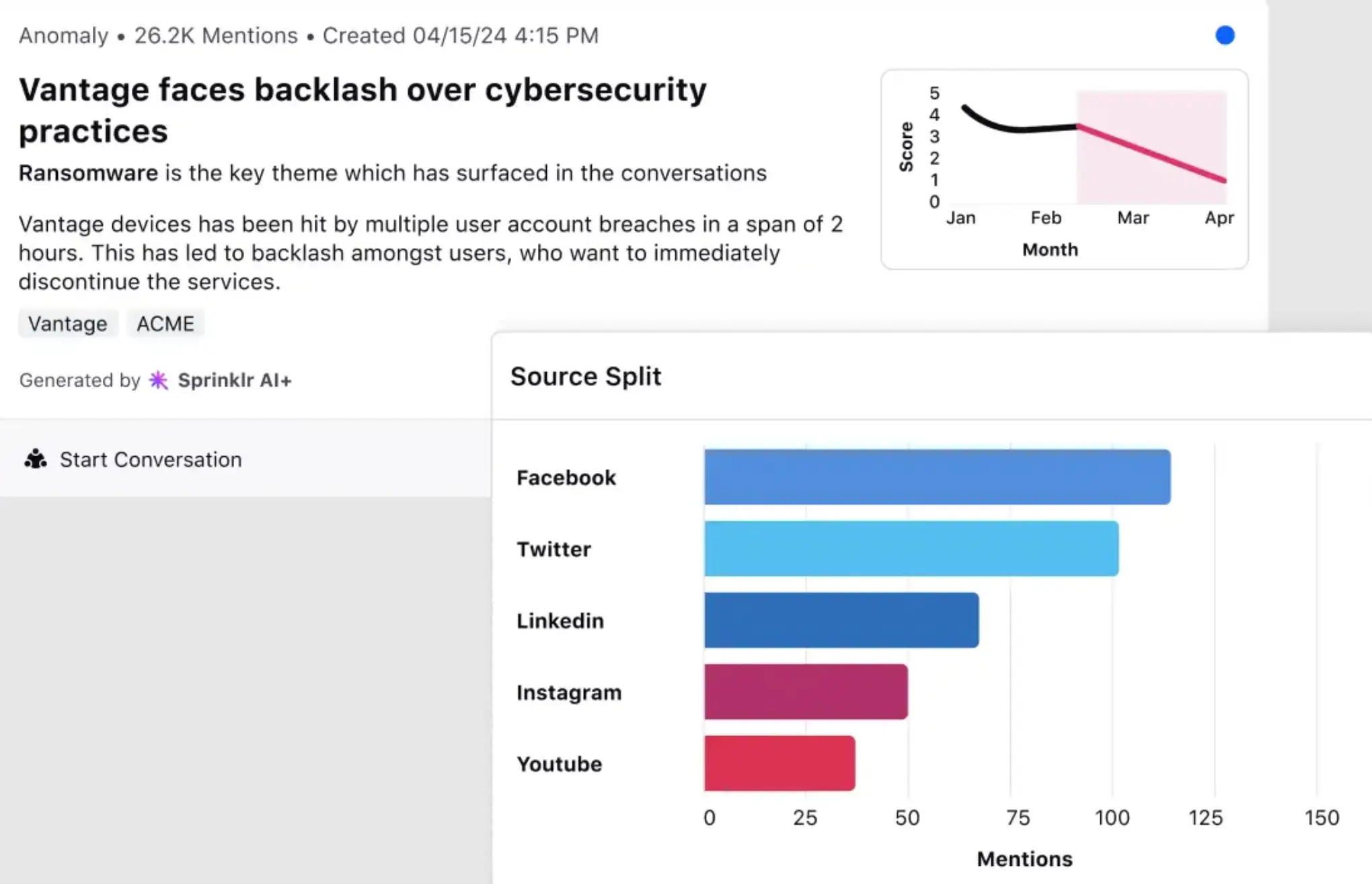
With AI-powered alerts and a super-simple setup, you can cut through the noise, catch early warning signs, and rally the right people for a coordinated, on-brand response. Plus, its dynamic dashboards and sentiment tools help you see what really happened, measure the fallout, and come back smarter every time.
The right action at the right time? That’s what protects your brand.
Best practices for social media crisis management in 2025
If you can't afford learning-by-failure, here are six best practices to help your brand stay prepared and resilient in 2025:
- Keep your crisis plan current: Platforms, audiences, and threats evolve constantly. Audit response workflows at least quarterly — update messaging templates, escalation paths, and approvals to reflect new teams, tools, and channels like Threads or Bluesky.
- Let AI do the early warning: Manual social media monitoring can’t keep pace with today’s fast-moving conversations. AI-powered social listening tools detect sentiment drops, viral spikes, and untagged threats — giving you the lead time to act before issues escalate. Sync approved messaging instantly across channels using AI to contain backlash with speed and consistency.
- Prepare before a crisis hits: Don’t wait for a crisis to hit. Run regular simulations using real-world data, stress test your processes, and have a ready-to-activate crisis playbook. The faster you can move when an issue surfaces, the more control you have over the narrative.
- Be transparent and timely: Silence creates space for speculation. Acknowledge issues early, even if all the facts aren’t known. Use a human, empathetic tone and outline next steps and timelines to reassure your audience and maintain trust.
- Run crises from a unified command center: Fragmented monitoring and communication slow everything down. A centralized hub that integrates real-time monitoring, AI alerts, escalation tools, and cross-functional collaboration ensures a streamlined, coordinated response.
- Measure performance and iterate: After a crisis, review metrics like sentiment recovery, resolution times, and engagement rates. Learn what worked (and what didn’t) and feed those insights into your next audit to continuously improve your crisis readiness.
Bonus: Enterprise crisis reports in the digital age
An enterprise social media crisis report is a living document that captures the full story of a crisis, from the first alert to final resolution. Typically, it includes:
✓ Incident timeline — when each milestone occurred
✓ Impacted channels — social platforms, communities, digital ecosystems
✓ Actions taken — who did what, when, and under which approval
✓ Sentiment shifts — tracked before, during, and after the crisis
✓ Resolution time & customer impact — how quickly issues were addressed and how customers responded
But a truly effective report goes further: it connects the dots between what happened, how your teams responded, and what can be improved next time.
For large organizations, these reports are essential because they:
→ Provide cross-team visibility, keeping Marketing, PR, Legal, and Support on the same page
→ Give executives the insights they need to make fast, informed decisions; summarizing not just what happened, but why and how it was handled
→ Surface learnings that sharpen future response playbooks, so the organization gets stronger with every incident
A great crisis report is timely, visual, and actionable. It pulls in real-time data from all relevant platforms, highlights sentiment shifts, and engagement spikes and clearly records who did what and when. Most importantly, it centers on customer impact and lessons learned, making it a practical tool for both immediate response and long-term improvement.
Manual reporting can slow teams down and leave gaps. That’s where Sprinklr comes in:
- Customizable dashboards let you track crisis metrics across 30+ channels in real time
- AI-powered alerts surface sentiment changes and potential threats before they escalate
- Crisis cards and summary reports make it easy to share key findings with leadership and stakeholders, keeping everyone aligned and ready to act
Wrapping it up: Stay agile and proactive
Social media crises in 2025 can happen faster and hit harder than ever before. The difference between losing trust and earning it back lies in how prepared you are. Brands that handle these moments well don’t do it by chance; they do it by putting the right processes, tools, and teams in place before they need them.
Take time to review your current crisis plans, identify any gaps, and pressure-test your workflows across teams. Consider rolling out AI-powered listening tools, automated response templates, and clear escalation paths that help your teams work together quickly and consistently. Solutions like Sprinklr Social can help you get there — starting small, proving value, and scaling up as you go.
When the next issue hits, be ready. Request a demo and see how Sprinklr can help your team stay prepared, responsive, and in control when it matters most.









